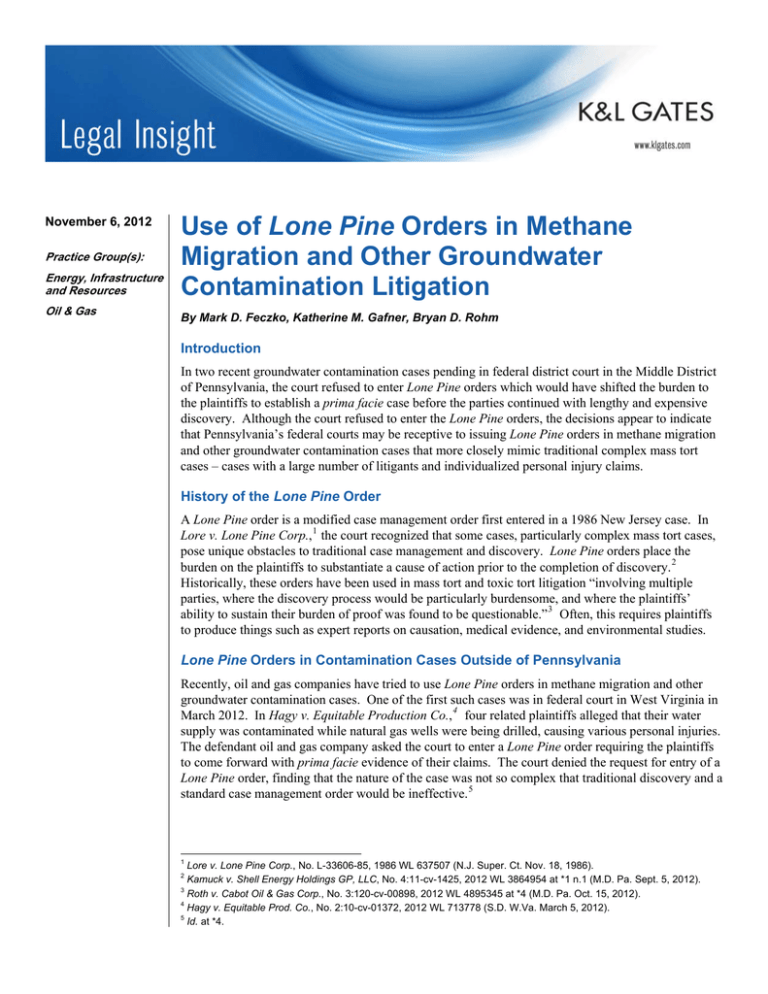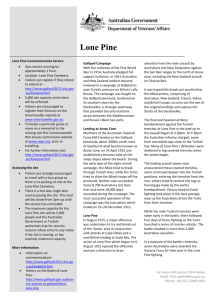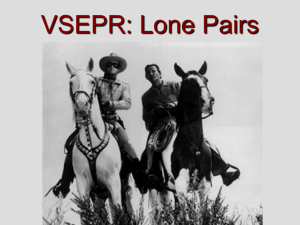Lone Pine Migration and Other Groundwater Contamination Litigation
advertisement

November 6, 2012 Practice Group(s): Energy, Infrastructure and Resources Oil & Gas Use of Lone Pine Orders in Methane Migration and Other Groundwater Contamination Litigation By Mark D. Feczko, Katherine M. Gafner, Bryan D. Rohm Introduction In two recent groundwater contamination cases pending in federal district court in the Middle District of Pennsylvania, the court refused to enter Lone Pine orders which would have shifted the burden to the plaintiffs to establish a prima facie case before the parties continued with lengthy and expensive discovery. Although the court refused to enter the Lone Pine orders, the decisions appear to indicate that Pennsylvania’s federal courts may be receptive to issuing Lone Pine orders in methane migration and other groundwater contamination cases that more closely mimic traditional complex mass tort cases – cases with a large number of litigants and individualized personal injury claims. History of the Lone Pine Order A Lone Pine order is a modified case management order first entered in a 1986 New Jersey case. In Lore v. Lone Pine Corp., 1 the court recognized that some cases, particularly complex mass tort cases, pose unique obstacles to traditional case management and discovery. Lone Pine orders place the burden on the plaintiffs to substantiate a cause of action prior to the completion of discovery. 2 Historically, these orders have been used in mass tort and toxic tort litigation “involving multiple parties, where the discovery process would be particularly burdensome, and where the plaintiffs’ ability to sustain their burden of proof was found to be questionable.” 3 Often, this requires plaintiffs to produce things such as expert reports on causation, medical evidence, and environmental studies. Lone Pine Orders in Contamination Cases Outside of Pennsylvania Recently, oil and gas companies have tried to use Lone Pine orders in methane migration and other groundwater contamination cases. One of the first such cases was in federal court in West Virginia in March 2012. In Hagy v. Equitable Production Co., 4 four related plaintiffs alleged that their water supply was contaminated while natural gas wells were being drilled, causing various personal injuries. The defendant oil and gas company asked the court to enter a Lone Pine order requiring the plaintiffs to come forward with prima facie evidence of their claims. The court denied the request for entry of a Lone Pine order, finding that the nature of the case was not so complex that traditional discovery and a standard case management order would be ineffective. 5 1 Lore v. Lone Pine Corp., No. L-33606-85, 1986 WL 637507 (N.J. Super. Ct. Nov. 18, 1986). Kamuck v. Shell Energy Holdings GP, LLC, No. 4:11-cv-1425, 2012 WL 3864954 at *1 n.1 (M.D. Pa. Sept. 5, 2012). 3 Roth v. Cabot Oil & Gas Corp., No. 3:120-cv-00898, 2012 WL 4895345 at *4 (M.D. Pa. Oct. 15, 2012). 4 Hagy v. Equitable Prod. Co., No. 2:10-cv-01372, 2012 WL 713778 (S.D. W.Va. March 5, 2012). 5 Id. at *4. 2 Use of Lone Pine Orders in Methane Migration and Other Groundwater Contamination Litigation Two months later, in a factually similar case, a court in Colorado reached the opposite result. In Strudley v. Antero Resources Corp., 6 four related plaintiffs brought tort claims against oil and gas operators seeking damages for personal injuries allegedly arising out of exposure to chemicals used in drilling operations. The court issued a Lone Pine order, requiring the plaintiffs to first provide the following before the case could proceed: a detailed expert opinion on causation; studies detailing the alleged contamination; details of the medical providers who treated plaintiffs; and an identification of the contaminants at issue. 7 The court recognized that over the course of the proceedings, the oil and gas operators presented evidence that: (1) government studies showed that there was no water contamination; (2) they had been operating in accordance with all applicable laws; and (3) their air emission-control equipment made it unlikely that the plaintiffs were exposed to harmful chemicals. 8 The court also decided that requiring the plaintiffs to establish a prima facie case was not unreasonable, as the plaintiffs would ultimately need to prove each element of their claims in order to succeed. 9 Once the plaintiffs provided the information required by the Lone Pine order, the court determined that the plaintiffs had not established the necessary elements of their claims, including proving that the oil and gas operators actually caused the purported injuries. 10 Specifically, the plaintiffs’ expert needed to opine as to “whether any and each of the substances present in the air and water samples can cause the type(s) of disease or personal injury that [p]laintiffs claim (general causation).” 11 Instead, the expert report simply stated that the evidence merited further investigation. 12 As a result, the court dismissed plaintiffs’ claims with prejudice. 13 Requests for Lone Pine Orders in Two Pennsylvania Contamination Cases Since the Colorado court issued a Lone Pine order in a contamination case in May 2012, two cases in federal courts in Pennsylvania have addressed whether Lone Pine orders can apply in methane migration and other groundwater contamination cases involving a small number of plaintiffs. In both cases, United States Magistrate Judge Carlson from the United States District Court for the Middle District of Pennsylvania declined to enter Lone Pine orders. Instead, he decided to follow the Southern District of West Virginia’s more conservative approach, electing to utilize the default procedures provided for in the Federal Rules of Civil Procedure and standard case management orders in cases involving a small number of plaintiffs without a complex factual basis. The first Pennsylvania case to address whether a Lone Pine order should be entered in a contamination case was Kamuck v. Shell Energy Holdings GP, LLC. 14 In Kamuck, a single plaintiff alleged that the defendants’ drilling activities contaminated plaintiff’s property and caused personal injury. 15 After engaging in some limited discovery, defendants asked the court to issue a Lone Pine order requiring the plaintiff to produce evidence sufficient to establish a prima facie case. Defendants’ request mirrored the evidence required by the court in Strudley, including: expert reports addressing 6 Strudley v. Antero Res. Corp., No. 2011-CV-2218 (Col. Dist. Ct. Denver Cty. May 9, 2012). Id. at p. 3. 8 Id. at p. 2. 9 Id. at p. 2. 10 Id. at p. 3. 11 Id. at p. 7. 12 Id. at p. 4. 13 Id. 14 Kamuck v. Shell Energy Holdings GP, LLC, No. 4:11-cv-1425, 2012 WL 3864954 (M.D. Pa. Sept. 5, 2012). 15 Id. at *1. 7 2 Use of Lone Pine Orders in Methane Migration and Other Groundwater Contamination Litigation causation, scientific studies showing contamination, information on plaintiff’s medical care providers, and the identity and quantity of contaminants attributable to defendants’ activities on the property. 16 Defendants also alleged that discovery had been going on for months, and despite the passage of time, plaintiff had produced little evidence that was relevant to support his claims. 17 Like the defendants in Strudley, the defendants in Kamuck also pointed out that the wells at issue had no health and safety violations and had been in compliance with all applicable laws.18 The court, however, was not persuaded and denied the request to enter a Lone Pine order on the grounds that the existing safeguards and procedures within the Federal Rules of Civil Procedure were adequate.19 A little over one month later, Magistrate Judge Carlson again considered whether to enter a Lone Pine order in another contamination case involving a small number of plaintiffs. In Roth v. Cabot Oil & Gas Corp., 20 two married plaintiffs alleged that actions during hydraulic fracturing had contaminated their property. 21 Initially, plaintiffs included personal injury claims, but these claims were later dropped. 22 Like the defendants in Kamuck, the defendants requested that the court enter a Lone Pine order requiring plaintiffs to produce evidence sufficient to establish a prima facie case. 23 Again, however, the court declined the request to enter a Lone Pine order, again finding that the court could adequately conduct the case using the available procedures under the Federal Rules of Civil Procedure. 24 In both Kamuck and Roth, the Middle District of Pennsylvania applied the same analysis to deny the requests for Lone Pine orders. First, the court noted that Lone Pine orders are traditionally applied in complex toxic tort cases with numerous litigants – which did not exist in either case. Second, the court noted that cases in which Lone Pine orders are entered generally involve situations where a party has refused to comply with discovery or, after some discovery, the plaintiff has failed to establish a prima facie case. 25 Third, the court outlined the following factors used to analyze whether a Lone Pine order is appropriate: (1) the posture of the litigation; (2) the case management needs presented; (3) external agency decisions that may bear on the case; (4) the availability of other procedures that have been specifically provided for by rule or statute; and (5) the type of injury alleged and its cause. 26 In addition, the court noted that it will consider the “case complexity and pleading defects” associated with the case. 27 Conclusion Although the Middle District of Pennsylvania declined to issue Lone Pine orders in these two recent cases involving claims by only a few plaintiffs for methane migration and other groundwater 16 Id. at *2-3. Id. at *5. 18 Id. at *6. 19 Id. at *6-7. 20 Roth v. Cabot Oil & Gas Corp., No. 3:120-cv-00898, 2012 WL 4895345 (M.D. Pa. Oct. 15, 2012). 21 Id. at *1. 22 Id. at *1 n.1. 23 Id. at *1. 24 Id. at *8. 25 Id. at *6. 26 Kamuck, 2012 WL 3864954 at *4 (citation omitted). 27 Id. at *4. 17 3 Use of Lone Pine Orders in Methane Migration and Other Groundwater Contamination Litigation contamination, the decisions appear to indicate that Pennsylvania’s federal courts may be receptive to using Lone Pine orders in such cases, but only when existing case management and discovery tools are insufficient. As a result, oil and gas companies faced with such litigation should be aware of the potential use of Lone Pine orders to effectively manage discovery costs and mitigate expenses in costly methane migration and other groundwater contamination cases. Authors: Mark D. Feczko mark.feczko@klgates.com +1.412.355.6274 Katherine M. Gafner kate.gafner@klgates.com +1.412.355.7412 Bryan D. Rohm bryan.rohm@klgates.com +1.412.355.8682 4




